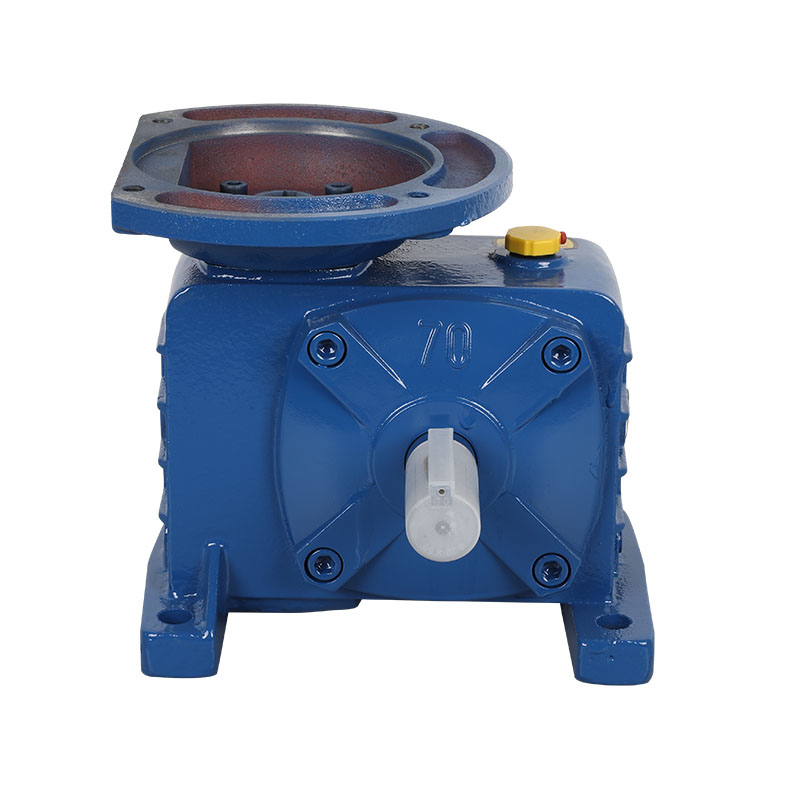The noise level and vibration control of WP single-stage worm gear reducers are one of the key factors in their operating efficiency and comfort. Due to the working principle of the worm gear transmission system, noise and vibration may be more significant than other types of reducers. Therefore, optimizing the noise level and vibration control is essential to extend the service life of the equipment, improve the comfort of the working environment and ensure the stability of the reducer.
The noise and vibration of worm gear reducers mainly come from the meshing between the worm wheel and the worm. In traditional worm gear transmission, since the tooth surface contact mode is sliding rather than pure rolling, friction and sliding will cause noise and vibration. In order to reduce these noises and vibrations, the meshing performance can be improved by optimizing the design of the gear. For example:
Through more precise gear manufacturing processes, uneven contact during meshing can be reduced, thereby reducing noise and vibration.
Using smoother worm wheel and worm tooth profiles to reduce tooth surface friction can help reduce operating noise.
Adjusting the angle of the worm can improve the smoothness of meshing, thereby reducing vibration and noise.
Lubricating oil plays a role in reducing friction, cooling and buffering in worm gear reducers, which directly affects noise levels and vibrations. To reduce noise and vibration, you can:
Choosing a suitable lubricant can reduce gear friction, reduce temperature rise, and thus reduce noise and vibration.
With the increase of use time, the performance of the lubricant will decrease, so regular replacement of the lubricant to ensure the normal operation of the lubrication system can keep the reducer running in a low-noise, low-vibration state.
In the design of the WP single-stage worm gear reducer, adding effective shock-absorbing structures and materials can significantly reduce vibration:
Adding shock-absorbing pads between the reducer and the mounting platform can effectively absorb vibration and reduce the impact of vibration on the equipment and the environment.
Adding special shock-absorbing designs to the structure of the reducer, such as soundproof covers or buffer materials, can effectively reduce the transmission of noise and vibration.
The choice of installation location will also affect the noise and vibration level of the reducer. The reducer should be installed on a foundation with high hardness and effective vibration isolation, and avoid installation in an environment that is prone to resonance.

Overload or uneven load will cause the vibration of the reducer to increase, so it is necessary to arrange the load reasonably during use to avoid the reducer running in a non-ideal state.
Using sound insulation materials on the housing or body structure of the WP single-stage worm gear reducer can effectively reduce the spread of noise:
The housing of the reducer can be wrapped with sound-absorbing materials to reduce the radiation of external noise.
Improving the sealing of the housing can not only prevent the entry of external pollutants, but also effectively control noise leakage.
Regular maintenance and inspection can ensure the normal operation of the various components of the reducer and avoid the increase of noise and vibration caused by wear or aging. Maintenance content includes:
Gear wear can lead to poor meshing, which in turn causes more noise and vibration. Regularly check the wear of the worm gear and replace damaged parts in time.
Ensure that the oil level and oil quality of the lubricant meet the requirements to prevent friction noise and vibration caused by insufficient lubrication.
The noise and vibration level of the worm gear reducer is closely related to the load it bears. Excessive load or excessive fluctuation will increase noise and vibration. Therefore, reasonable load management is crucial to reduce noise and vibration:
Avoid sudden changes and uneven distribution of load to reduce the impact and vibration of the reducer.
Avoid overloading the reducer for a long time. Overloading will not only reduce efficiency, but also increase noise and vibration.
The noise and vibration problems of the WP single-stage worm gear reducer mainly come from the meshing process of the worm and worm, the state of the lubrication system, and the installation environment of the equipment. By optimizing the gear design, improving the lubrication system, increasing the shock absorption design and materials, optimizing the installation position and other measures, the noise and vibration can be significantly reduced, and the operation stability and comfort of the equipment can be improved. At the same time, regular maintenance and load management are also essential to keep the reducer running in a low-noise and low-vibration state.

 English
English русский
русский bahasa Indonesia
bahasa Indonesia
